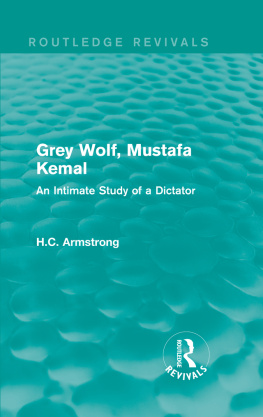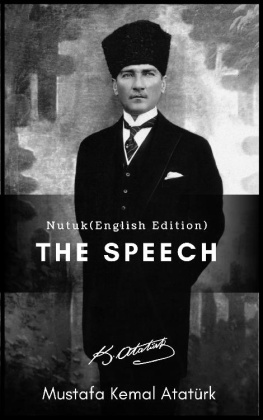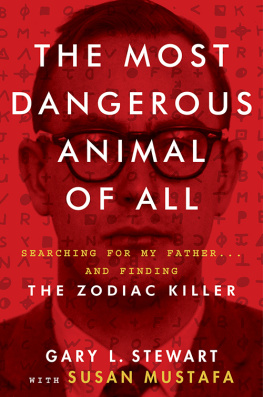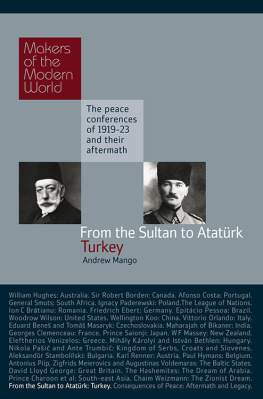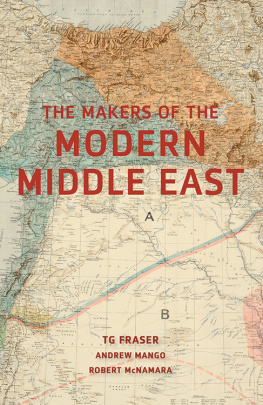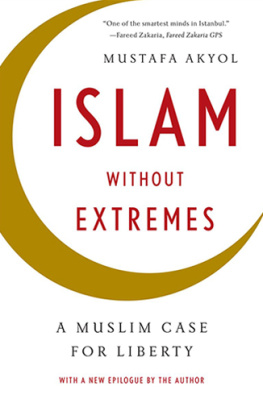Routledge Revivals
Grey Wolf Mustafa Kemal
Mustafa Kemal was known both as a vicious dictator and the iron-willed creator of modern Turkey however little was known about him as a person and he was viewed as an enigma by many. Originally published in 1932, Armstrong delves into Kemals career and personal life in great detail showing how he moved between revolutionary, soldier and politician whilst also discussing his love of women, drinking and gambling to present a clear picture of the infamous ruler. This title will be of interest to students of History and Middle-Eastern Studies.
Grey Wolf Mustafa Kemal
An Intimate Study of a Dictator
H.C. Armstrong
First published in 1932
by Arthur Baker Ltd
This edition first published in 2016 by Routledge
2 Park Square, Milton Park, Abingdon, Oxon, OX14 4RN
and by Routledge
711 Third Avenue, New York, NY 10017
Routledge is an imprint of the Taylor & Francis Group, an informa business
1932 Arthur Baker Ltd.
All rights reserved. No part of this book may be reprinted or reproduced or utilised in any form or by any electronic, mechanical, or other means, now known or hereafter invented, including photocopying and recording, or in any information storage or retrieval system, without permission in writing from the publishers.
Publisher's Note
The publisher has gone to great lengths to ensure the quality of this reprint but points out that some imperfections in the original copies may be apparent.
Disclaimer
The publisher has made every effort to trace copyright holders and welcomes correspondence from those they have been unable to contact.
A Library of Congress record exists under LC control number: 33003192
ISBN 13: 978-1-138-99955-8 (hbk)
ISBN 13: 978-1-315-65817-9 (ebk)
GREY WOLF
By the same Author
LORD OF ARABIA
TALES OF HAZARD
TURKEY AND SYRIA REBORN
ON THE RUN
UNENDING BATTLF.
TURKEY IN TRAVAIL
HIDDEN
GREY STEEL

H. C. ARMSTRONG from a drawing by Augustus John
GREY WOLF
MUSTAFA KEMAL
An Intimate Study of a Dictator
by
H. C. ARMSTRONG
FOURTEENTH EDITION
METHUEN & CO. LTD. LONDON
36 Essex Street , Strand, W.C.2
Originally published by Messrs. Arthur Barker Ltd. in October 1932 First published by Methuen & Co. Ltd. in August 1939 It has been reprinted thirteen times Fourteenth edition, 1947
CATALOGUE No. 3330/u
THIS BOOK IS PRODUCED IN COMPLETE CONFORMITY WITH THE AUTHORIZED ECONOMY STANDARDS
PRINTED IN GREAT BRITAIN
I WISH to thank innumerable friends and acquaintances who have placed their personal knowledge at my disposal, but who must remain unnamed, and also:
- The Times.
- The Royal Institute of International Affairs.
- The Oriental School of Languages.
- The Royal Central Asian Society.
for placing much material in my hands and treating me with unfailing kindness.
H. C. A.
Author's Note
Names and their Spelling
I Spelling of Names
WHEN Turkish was written with Arabic letters each European writer transcribed names as he saw fit. The result was as chaotic as the Tower of Babel. Rauf might be Raouf or Rouf. Khalif, Calif or Caliph. Hourchid, Hurshid or Hoursheid or Khurshid or Hoorsheed.
In 1928 Mustafa Kemal introduced the Latin Script. He ordered that certain of the Latin letters be given artificial sounds to correspond with the sounds of Turkish and Arabic.
These have to be learned betore the words can be pronounced. They have been adjusted several times since 1928, and will require more adjustment in the future.
Thus Jemal, which might have been Djemai, has become Cemal. Abdul Hamid has become Abdulhamit or Aptul-hamit.
I have ignored the new Turkish alphabet. Outside Turkey it is not known. I have retained the names as best known to English-speaking readers, but in their simplest form.
Thus R auf instead of Raouf or Rouf, and Jemal instead of Cemal or Djemal.
II Place-Names
THE Turks have of late changed the names of many places. Thus they have changed Smyrna to Izmir. I have retained the form best known to English-speaking readersi.e. Ankara and Smyrna, etc.
III
I HAVE been repeatedly asked whether the conversations quoted verbatim in Grey Wolf are actual or fictional. Every quotation and conversation quoted verbatim in my Grey Wolf with the exception of two which are of very minor importance and for which the evidence is less assured has been supplied by Mustafa Kemal or obtained from documentary or verbal sources which have been severely tested and carefully weighed before their veracity and value have been accepted.
Some latitude must naturally be allowed in the wording as nearly all are translations.
Introduction
IN the thirteenth century after Christ there came the Great Drought. From the Wall of China throughout all Central Asia the land was cracked and parched for want of rain, and the tribes were on the move searching for new pastures for their flocks. Among them were the Osmanli Turks, whose chief, Sulyman Shah, carried on his banner the head of the Grey Wolf.
They were cruel and primitive, these Osmanli Turks, animal-strong with slit eyes in flat Mongol faces. They were as brutal and relentless as the grey wolves which hunted over the wide steppes of the fierce countries of Central Asia. Yet they were disciplined, by the dangers and risks of their nomad life, to rigid obedience under their leaders.
For centuries they had pitched their black horse-hair tents in the Plains of Sungaria on the edge of the Gobi Desert. Forced by lack of water and grass Sulyman Shah led out his people and made westward. Finding the Hordes of Tartars to his north and pressing in behind him, he turned south, and so came, through Armenia into Asia Minor, into Modern History.
Sulyman died and Ertoghrul reigned in his stead, and after him came Emir Othman and Sultan Orchan, and from father to son ten generations of sultans followed each other. Often brutal and vicious, often unjust and bestial, they were rulers, leaders of men, and generals.
They found in front of them a world of dying empires, the decayed Seljuk, the worn-out Arab Empire of Baghdad and of the Caliphs, and the corrupted Byzantine. These they smashed and conquered.
Within three hundred years of the death of Sulyman Shah, his tenth descendant, Sultan Sulyman the Magnificent, the Law Giver, ruled with justice and strength an immense empire which stretched from Albania on the Adriatic coast to the Persian frontier, from Egypt to the Caucasus. Hungary and the Crimea were his vassals. The sovereigns of Europe came with presents asking his help in their quarrels. His armies stood across the road to the East. His fleet sailed supreme in all the Mediterranean. North Africa acknowledged his suzerainty. Constantinople was his. He made one great bid for World domination. In 1580 he hammered on the gates of Vienna and seized Christendom by the throat.

